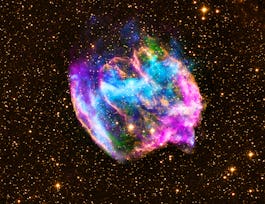Ever since our ancestors ventured onto the African savanna, human beings have searched, explored, and wondered about the world. Nowadays, and certainly for most, science is the vehicle that takes us along a path towards understanding nature. It can bring us from sub-atomic realms to the most distant galaxies. Largely through the discipline of geology, science allows us to push back the mists of time and peer into a past measured in billions of years, and aptly referred to as “Deep Time.”



Deep Time: Discovering an Ancient Earth

Instructor: Alan Lester
Sponsored by Mojatu Foundation
2,130 already enrolled
(19 reviews)
Recommended experience
What you'll learn
Communicate and teach the underpinnings of geology and deep time.
Evaluate the evidence supporting the age of the earth, and review the geologic story of the Rocky Mountains.
Apply geological data, models, and investigations.
Skills you'll gain
Details to know

Add to your LinkedIn profile
4 assignments
See how employees at top companies are mastering in-demand skills


Earn a career certificate
Add this credential to your LinkedIn profile, resume, or CV
Share it on social media and in your performance review

There are 4 modules in this course
We might well be the first species to ask, and even begin to answer, some big questions about the world around us: Who are we? Where are we? and When are we? Geology joins some heavy hitters, like evolutionary biology and cosmology, when it comes to providing major insights, particularly into the latter question.This first module begins with a look at science in general, how it works and where it came from. We then address the historical beginnings of a “science of the earth” (geology) and how, from its very inception, it pointed towards an earth of immense age, the business of Deep Time. The module wraps up with an introduction to the assessment of rock and mineral age determination using both qualitative and isotopic methods.
What's included
6 videos1 assignment2 discussion prompts
The power of science is no better exemplified than through its ability to peer into the most remote depths of Deep Time. In this second module we take a cursory “highlight trip” through a host of very ancient and key origins, from the universe itself to stars and planets, and then to Earth’s first oceans, atmosphere, crust, and life. We take a literal deep dive into the underpinnings of the North American continent, the so-called Precambrian basement. Using rock and mineral analysis, radiometric dating, seismology, and the treasure trove of deep-earth materials brought to the surface by kimberlitic “diamond-pipe” eruptions, geologists have put together an understanding of how North America, and continents in general, grow through time.
What's included
5 videos1 assignment
We tackle the story of North America, as it emerges from the Precambrian into the Phanerozoic Eon (i.e., Paleozoic, Mesozoic, Cenozoic Eras). The story is read from the book of rock layers, and as such we review some of the language of geology—rocks and the rock-cycle. We VISIT (via both lecture and virtual-video-field trip) the puzzling yet pervasive Great Unconformity, an enormous gap in the rock record that sits directly below the first strata with shell fossils. We consider the marine waters that washed onto and off the land, as climate and tectonics drove changes in sea-level. Lastly, as the Pangea Super-Continent coalesced in the Late Paleozoic, we see the rise of the Ancestral Rocky Mountains. Note: This module contains the first two of three Video Field Trip Outings to Flagstaff Mountain, near Boulder, Colorado.
What's included
6 videos1 assignment1 discussion prompt
Moving into the final phase of Earth history in the Rocky Mountains, the Mesozoic and Cenozoic Eras, the geological record provides greater resolution and reveals, with rather exceptional detail, the location and timing of mountain uplifts, ocean incursions, changing climate, and the fossil record. The modern Rocky Mountains turn out to be a consequence of uplift, erosion, and then renewed uplift with a final sculpting via glacial ice. We conclude by coming full circle, back to science itself— recognizing it as more than simply a tool for reconstructing nature and the past, but also carrying a charge of responsibility for assessing truth and evaluating claims within our own lives and the present world. Note: This module begins with the third and final Video Field Trip Outing to Flagstaff Mountain, near Boulder, Colorado.
What's included
5 videos1 assignment1 discussion prompt
Instructor

Offered by
Why people choose Coursera for their career




Learner reviews
19 reviews
- 5 stars
78.94%
- 4 stars
21.05%
- 3 stars
0%
- 2 stars
0%
- 1 star
0%
Showing 3 of 19
Reviewed on Oct 21, 2023
Excellent, highly understandable presentation of complex material! I really learned a lot from this course, and I'm very grateful.
Reviewed on Jun 22, 2022
Excellent course very well presented by Alan Lester -loved his enthusiasm and lucid explanation of concepts. Strongly recommended.
Reviewed on Sep 26, 2023
The course was well made and well taught, would definitely recommend to anyone who is interested in Geosciences.
Recommended if you're interested in Physical Science and Engineering

Yale University

University of Virginia

Rutgers the State University of New Jersey

Open new doors with Coursera Plus
Unlimited access to 10,000+ world-class courses, hands-on projects, and job-ready certificate programs - all included in your subscription
Advance your career with an online degree
Earn a degree from world-class universities - 100% online
Join over 3,400 global companies that choose Coursera for Business
Upskill your employees to excel in the digital economy



